Facebook’s project Aquila is aimed at providing the access of internet everywhere, with the help of solar-power drones that will throw the signal to the ground. But before we move on let’s make sure you can pronounce Aquila (uh-KEY-luh) in its correct voice. This is important you are going to read that name a lot.
Facebook’s flight to the sky was an event so important, that neither its top executives nor its founder could afford to sleep on it. This event was meant to be beautiful and those interested in Facebook’s wellbeing had to witness it. But the goals seemingly stretched well beyond just facebook. It involved the betterment of everyone in terms of access to the internet.
So let’s take account of the big Facebook event in an archival manner.
The location was already crawling with Facebook employees, including executives.
Mark Zuckerberg woke up at 2am on June 28th and flew down to aviation testing facility in Yuma, Arizona, arriving right before the dawn. The location was already crawling with Facebook employees, including executives. However, among the crowd, the most excited group was the team of engineers that had been working on project Aquila under the hood. It was natural that arrival of Facebook founder added more to the nervousness than to the excitement.
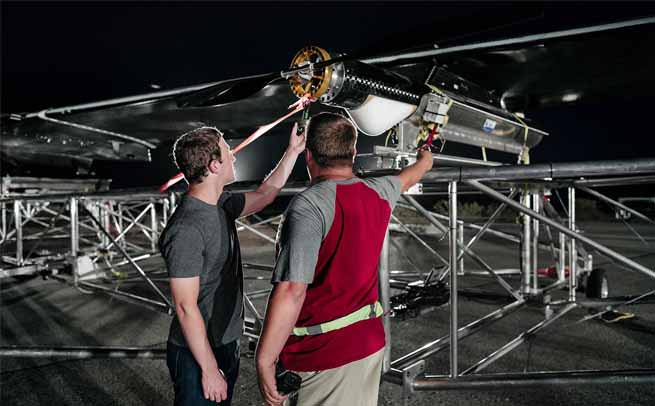
These were the decisive hours. Project Aquila was straight on nothing ever seen before. The project team was tasked with building a solar-powered drone, that would fly at the high altitudes and was capable of carrying the equipment necessary to channel the internet to the Earthlings below it. This was a hardcore feat and today was the day of reckoning. It was the day thousands of human working hours were going to be put to the test.
Zuckerberg admitted that he couldn’t resist flying to Yuma when the hours came close.
The core team comprised of just two dozen individuals. Aquila wasn’t built in a single safe location. The different parts of the drone came to life inside the engineering labs from Southern California to labs elsewhere in the UK. Towards the final months, the team had moved to Yuma deserts, where the Facebook’s dream to touch the sky were hopefully going to meet fulfillment. The morning of June 28, was going to be the sum of all their combined efforts: a functional test flight.
The minimum goals set for the test flight were that it would take off safely and maintain a stable flight for at least 30 minutes before touching the ground in one piece. It really seems like a very small ask for such a huge endeavor, but that was all it was required at least in the beginning. Zuckerberg wasn’t required to be there but he admitted that he couldn’t resist flying to Yuma when the hours came close.
For Zuckerberg, it wasn’t just a test flight, it was the first step that was going to create a stairway leading to 7 billion people on the planet with happy tidings. The happy tiding of internet access and through it, education, knowledge, and a strong connection between different nations of the world. This was something that was going to help alleviate poverty. In other words, it was the long-sought dream of human globalization.
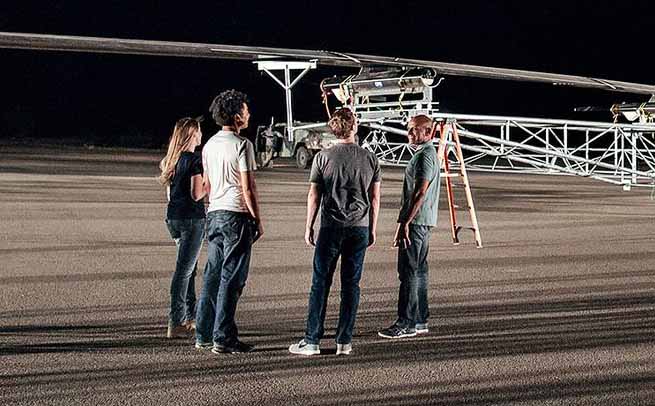
The moment of truth finally arrived. The sun raised its head from the horizon, signaling the Facebook works to set project Aquila off into the air. A crane place Facebook’s prototype drone into the dolly frame that propelled the plane into the sky. On the ground, people gazed amazed a giant 141-foot wing giant slowly rising towards the morning colored sky. The dream had become true.
Aquila is meant to be slow.
On the ground, there were people. Happy, elevated, clapping, wiping off tears of their eyes. There was a strong two-year worth of reasons behind those humid eyes. But was it something supersonic? No. Unlike an aircraft that is meant to fly people and cargo between the two destinations as fast as possible, Aquila is meant to be slow, but just fast enough to keep gliding in the air. The drone is not in a hurry to get anywhere.
This is because Aquila is not a lonely plane. A fully functional drone-based internet system would comprise of thousands of such drones flying at the heights of 60,000-90,000-feet. That is well above international airlines. No other flying object can halt their way. The fleet will fill the every net-less gap in the sky, relaying signals with other drones and users on the ground after converting the laser signals into the internet.
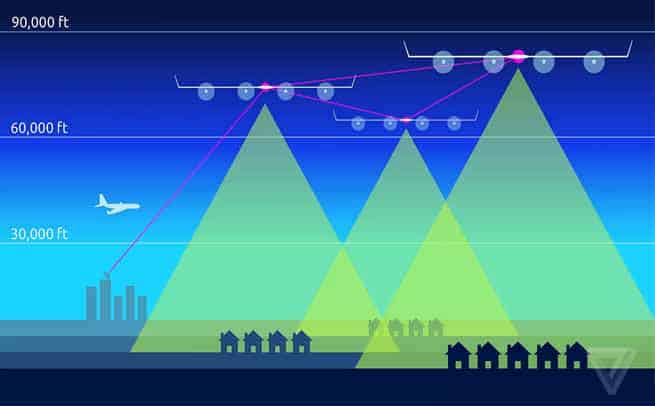
This isn’t the only project that aims to web the entire world, there are minisatellite and Google’s project Loon as well. Then why Facebook chose drone over other options? The answer is accessibility in high population density areas. Internet balloons and satellites can efficiently deliver the internet to the villages and outskirts, but the quality of internet signal can be gobbled up in the urban area where a great number of users are significantly high.
Cost-cut on establishing a global internet network also means cheaper internet.
Furthermore, a network of cellular towers, currently used by the telecom companies, are too much expensive to be deployed everywhere even for multi-billion global tech giants like Google and Facebook. Drones, on the other hand, are a much practical solution for both the service providers and users as well because cost-cut on establishing the network also means cheaper internet.
Back in 2014, when Mark Zuckerberg was still shuffling through the internet delivery techniques, he pointed out that drones can efficiently deliver the internet to medium-sized cities and the outskirts of urban areas. Which seems to be Facebook’s main focus. Aquila will fly closer to the ground than satellites, which gives it an advantage of better signal quality because the signals get distorted at longer distances.
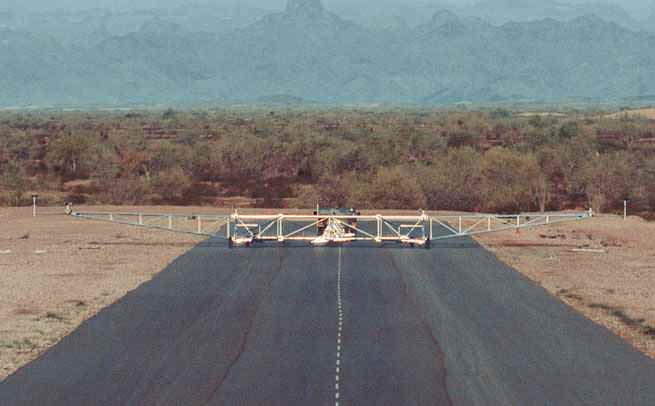
Facebook creator’s original idea was a drone power by the Sun, which would fly consistently for 90 days throwing the internet on to the populations within a 50-km radius. That idea struck Zuckerberg so much that he set out to lock on it with full funding and support. He decided to build a team that would comprise experts from likes of Ascenta, NASA’s Jet Propulsion Laboratory, and MIT’s Media Lab. That was 26 months ago.
On the morning of July 28th, the 26-month long ambition had come to life. It took $20 million investment to acquire Ascenta; an aviation consultancy. Which was an important step Ascenta’s team leader Andy Cox was the only mechanical engineer who had been able to keep a solar-powered drone in the air for two weeks; a still unbroken record. Cox became Zuckerberg’s right hand on the project Aquila.
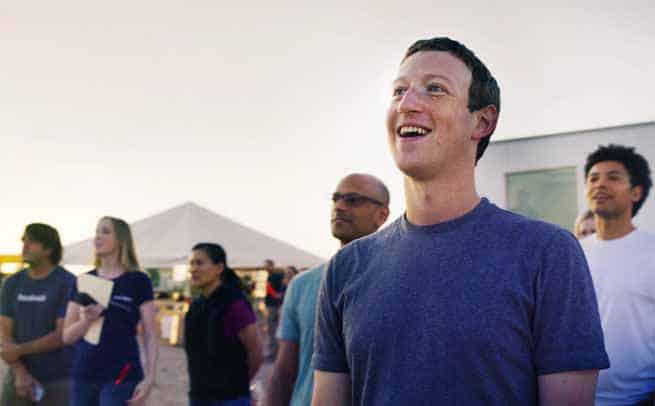
ACCOMPLISHMENTS
- Aquila only used 2,000 watts of energy. In other words only the output power of five strong cyclists to fly a drone with a wingspan (141-foot) much larger than a Boeing (113-foot).
- The carbon fiber body helped cut down the total weight of the drone down to 900-lbs, which is even less than an average lightweight sports car.
- Originally, the project Aquila team had aimed at a 30-min flight plan, but after a stable performance and out of excitement, they kept it in the air for over an hour (90 minutes) without any faults.
Facebook is not planning the production of Aquila drones, instead, the company would support the other companies who will undertake it. According to Mark Zuckerberg, Facebook’s aim was to show the world that it can be done. This tells us that soon the umbrella of our sky will be teeming with internet drones, satellites, and balloons.

